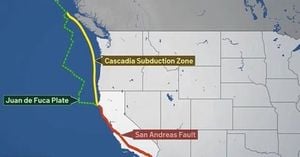Raleigh, North Carolina, is bracing for a stretch of unsettled weather as the National Weather Service (NWS) forecasts showers and thunderstorms through the early days of August 2025. Residents should prepare for wet conditions starting Friday, August 1, with a 60% chance of rain and storms mainly after 3 p.m., according to the latest updates. Despite a calm wind shifting north and high humidity hovering around 90%, the atmosphere is ripe for precipitation, setting the stage for a soggy end to the week.
The evening outlook for August 1 includes a 50% chance of thunderstorms before 4 a.m. on August 2, followed by lingering light showers past 5 a.m. Temperatures will dip to a low near 69°F overnight, while rainfall amounts are expected to be generally light—less than a tenth of an inch—though more significant downpours could occur within thunderstorms. Winds will remain gentle from the northeast, unlikely to clear the moisture quickly.
Saturday, August 2, offers a slight reprieve with a reduced 20% chance of precipitation and mostly cloudy skies. High temperatures will reach near 82°F, with a northeast breeze at about 9 mph providing a gentle stir. By Saturday night, skies should partially clear, cooling to around 65°F as winds ease. However, the NWS still flags a slight 20% chance of showers before 2 a.m. Sunday, signaling that the wet weather pattern is far from over.
Looking beyond the weekend, the forecast suggests a pattern of mostly sunny days and partly cloudy nights. Monday, August 4, is expected to bring intervals of clouds and sunshine with highs near 85°F and lows around 68°F. Winds will remain light and variable, marking a modest return to more typical summer conditions.
Despite the seemingly moderate outlook, officials urge vigilance. The NWS has issued a Hazardous Weather Outlook highlighting a "Marginal to slight, level one to level two of four risk of excessive rain" for August 1 and its overnight hours. This warning points to the potential for episodic flash flooding, especially in areas where thunderstorms intensify. Additionally, a "Marginal, level one of five risk of severe thunderstorms" remains in effect, with isolated storms capable of producing damaging winds. One such storm was spotted at 7:03 p.m. on August 1 between Garner and Cary, moving south at 25 miles per hour. This prompted a severe thunderstorm warning for southwestern Wake, northwestern Johnston, and northeastern Harnett counties, with wind gusts reaching 60 mph. The warning was set to expire at 7:30 p.m., but it served as a stark reminder of the volatile weather conditions affecting central North Carolina.
Current conditions on August 1 reinforce the unsettled nature of the weather. Thunderstorms rolled through Raleigh with temperatures around 76°F, humidity at 82%, and northeast winds at 8 mph. Rainfall measured 0.03 inches during the storms, while cloud cover remained nearly complete through the evening hours, with temperatures gradually falling into the low 70s by 11 p.m.
While this wet spell may dampen outdoor plans, it follows an exceptionally hot July 2025 at Raleigh-Durham International Airport (RDU). The month set records as the hottest July on record, with an average temperature of 84°F—3.5 degrees above the normal daily average. The average high was an intense 93.5°F, and the average low stood at 74.5°F. Meteorologist Aaron Swiggett noted, "That’s pretty significant. Not too surprising but, yeah, that’s quite warm." July’s heat wave extended beyond Raleigh, ranking among the top five or ten warmest Julys across much of North Carolina.
Raleigh also experienced the second-highest number of 90-degree days in July, totaling 27. The month saw five new record-high minimum temperatures, including a sweltering record low of 80°F on July 18. The highest temperature recorded at RDU was 99°F on July 27, while the lowest was 68°F on July 23, illustrating the extreme heat fluctuations during the month.
These heat records come amid broader global warming trends. The National Oceanic and Atmospheric Administration (NOAA) and NASA have declared 2024 the hottest year on the planet so far, followed by 2023. NOAA data show Earth’s temperature has risen by an average of 0.11 degrees per decade since 1850, amounting to roughly a 2-degree increase overall, largely driven by fossil fuel emissions trapping heat in the atmosphere.
Looking ahead, North Carolina is expected to experience somewhat cooler weather for the first week of August, thanks to a strong cold front that will keep highs in the low to mid-80s. However, NOAA’s Climate Prediction Center forecasts temperatures trending above average from August through December, suggesting that the recent heat may be part of a longer-term warming pattern.
In addition to heat and rain, North Carolina is entering the historically busiest phase of hurricane season, spanning mid-August through September. As of August 1, meteorologists were monitoring an area in the western Atlantic for possible development later in the month, though no immediate tropical threats were expected within the next week.
With the combination of record-breaking heat, a surge in thunderstorms, and the looming hurricane season, residents of Raleigh and central North Carolina face a complex and dynamic weather landscape. Staying informed and prepared for sudden changes, from flash floods to severe winds, remains essential as the region navigates the transition from a scorching July to an unsettled August.




